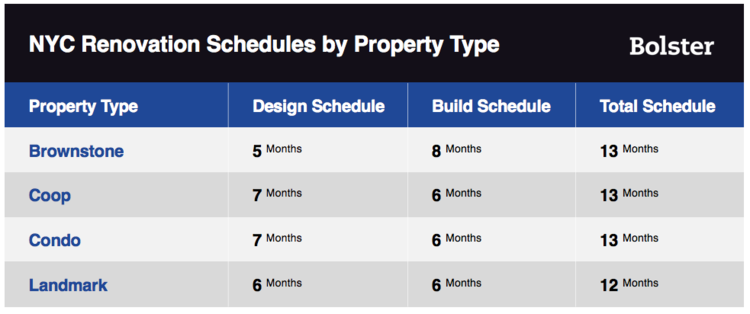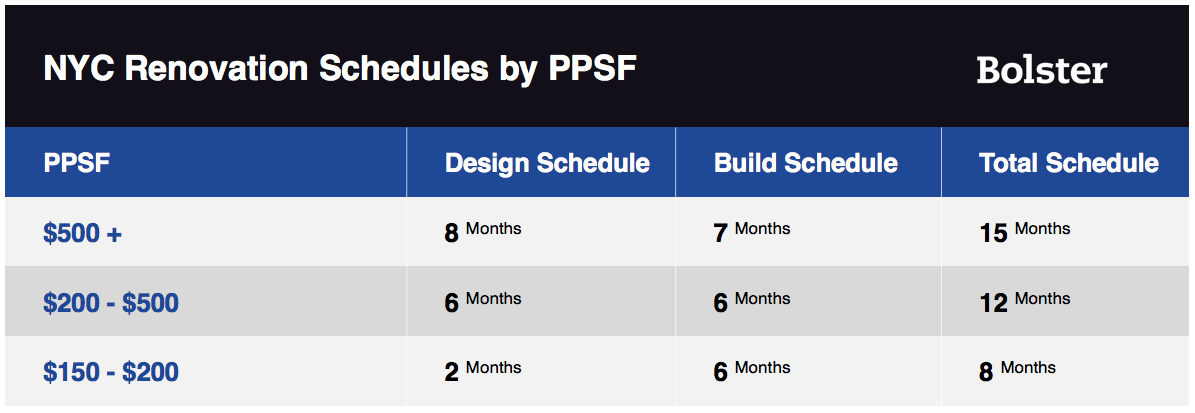How long does a NYC renovation take? The design process makes all the difference

If you’re thinking of renovating your NYC home, your second most burning question (after “How much will it cost?) is probably “How long will it take?”
By analyzing two years’ worth of completed projects, Bolster—a New York City company that has designed a transparent and enjoyable process for area homeowners doing major renovations—has been able to remove some of the guesswork out of back-of-the-napkin timeline estimates.
What Bolster found is that in the first quarter of each year, there is a huge surge in interest from homeowners hoping to begin their projects in the summer. But despite this, their data--corroborated by DOB permit records--reveals a uniform distribution of start dates. What this means is that despite homeowners' best intentions, there are a number of factors that can impact when a renovation begins.
“We found that the biggest variable in renovation schedules is the design process (that is, engaging an architect to help you design and obtain Government Agency and building management approvals for your project) which can take anywhere between a month and over a year, depending on factors like property type, the scope of work, and price per square foot,” says Bolster founder and CEO Fraser Patterson.
The table below breaks down the range of timing for different phases of renovations that Bolster looked at:

Your design team
Many renovators mistakenly assume that their expeditor is the one with the power to speed up a project. An expeditor’s role, after all, is to make sure that all the correct steps are followed when it comes to filing paperwork with the Department of Buildings.
Bolster’s analysis of its project data found that selecting a seasoned architect had more impact on speed.
“You want to hire an architect who has experience with your property and project type, and understands how to work with the government agencies and building management whose approvals you need, “says Bolster’s Patterson. “They’ll handle the negotiations that ensure you’ll get all the necessary approvals for your renovation swiftly.”

Property type
The length of your project’s design phase also depends on the type of home you live in. Expect a lengthier undertaking if you’re renovating a co-op, condo, or landmark building versus a brownstone (more on that below.)
Co-ops
If you’re renovating a co-op, you may have some challenging conversations with your building’s own architect in store.
“They can be very diligent and stringent, more so than your architect because they’re protecting the interests of the building,” Patterson explains.
Co-op boards may also delay your design process, especially if your board meets infrequently and won’t get around to approving your project for a few months. If there’s no precedent in the building for the type of work you plan to do—like, for example, vertical apartment combinations—this can necessitate more in-depth research and discussion—and delays. Whether or not your building has a thorough alteration agreement in place (that is, a contract between shareholders and the board or management company laying out the rules for renovations) will influence the length of these board negotiations too.
Another potential snag can arise if your renovation could impact a neighbor’s apartment. For example, if your project involves structural work that affects the supporting walls of neighboring apartments, or is a rooftop renovation that affects the membrane of the building, you may need to enlist a structural engineer and provide additional documentation both before and after the work is undertaken to protect their property.
Condos
Condo owners face many of the same potential causes of delays as co-ops, though their boards and alteration agreements are often more relaxed than those of coop owners.
Landmark properties
Owners of landmarked properties must undergo a different kind of headache: Having their proposed project subject to a public hearing, which can be a frustratingly open-ended process—and depends on the attitude and knowledge of the review officer. (If you’re not sure whether your building is landmarked, you can check on the DOB’s website, which notes the landmark status of every building in NYC.)
Brownstones
Despite often being historic properties, brownstones tend to have the quickest design phase, because owners do not have to contend with management or a building’s architect. However, the structure of brownstones occasionally poses logistical challenges—think trees obstructing the work, or the lack of an elevator slowing the transport of materials up and down stairs.

You Might Also Like
Scope of work & type of project
A good rule of thumb is that the more changes you make to the layout—and reconfigure systems like HVAC, electrical, and plumbing—the more regulatory challenges you’ll encounter, which eat up time. The specific kind of project you’re undertaking naturally affects your design timeline:
Rooftops
Bolster found that rooftop terraces tend to take the longest to revamp—20 months on average. Because these projects entail a higher degree of danger, they also require more thorough planning and construction. Owners typically need to enlist structural engineers and other specialists, and the types of products they’re installing—like bespoke skylights—may require custom manufacturing.
The time of year has a bigger effect on rooftop renovations than on other types of projects. If a homeowner gets approval for the work in the winter, high winds, low temperatures, and storms may require mandatory shut downs of work.
“Of course, homeowners prefer to get approvals in the spring or summer, but timing that is very difficult,” Patterson says.
Apartment combinations
Like rooftop work, apartment combinations often involve hiring specialists like structural engineers to prevent running into unforeseen structural issues. These projects are also more frequently plagued by requests to stop work from neighbors who are concerned about site safety and cleanliness. And as with any project, a building superintendent who isn’t thrilled about the renovation can cause delays, for example, by preventing workers from using building elevators.
Gut renovations
Gut renovations are more straightforward, and tend to move faster than rooftop renovations or combinations. However, as with any large-scale project, expect greater scrutiny from the Department of Buildings and your building management. And remember that more back-and-forth means more revisions, and a longer design process.
Cosmetic renovations
Purely cosmetic renovations, which don’t involve the moving of waste and supply lines, typically don’t require approval from the DOB, which means they move faster—unless, that is, unless you are the one causing delays.
“Design changes that owners make along the way are the most common cause of delays on cosmetic renovations,” Patterson explains. And especially when they’re on a tight budget, clients will need more input from their architect in making smart, cost-effective design choices.

Price per square foot
Bolster found a direct correlation between the price per square foot and the timeline for design. Projects that cost $500 per square foot and up take on average eight months to design, while those that cost between $150 and $200 take a mere two months.
Higher-end renovations may bring with them a larger design team—perhaps an architect, interior designer, and a structural engineer—which means more back-and-forth, more meetings, and a slower design process. Sometimes, too, renovations are costlier because clients want custom fixtures and fittings that aren’t readily available.
At the $200 to $500 per square foot level—in which the design phase lasts on average 6 months—the challenge of optimizing homeowners’ budgets, through extensive research and multiple visits to showrooms, can trigger delays.
“Just as careful advance planning and a clear vision of what you want help keep your project on budget, the same due diligence means you’ll be able to streamline your design phase and move your project along as fast as possible,” says Patterson.
Every year, New Yorkers waste over $700M following the usual renovation process. Bolster is different, using a scientific approach to match you with the highest-quality professionals and financially guarantee your project is delivered beautifully for a fair price - all at no extra cost.
To start your major home renovation project, visit bolster.us
More from Bolster:
Here's how much it costs to renovate and expand a house in Hudson Valley, N.Y
Here's how much it costs to renovate a rooftop terrace in New York City
Here's how long it takes to gut renovate a three-bedroom apartment in NYC






























